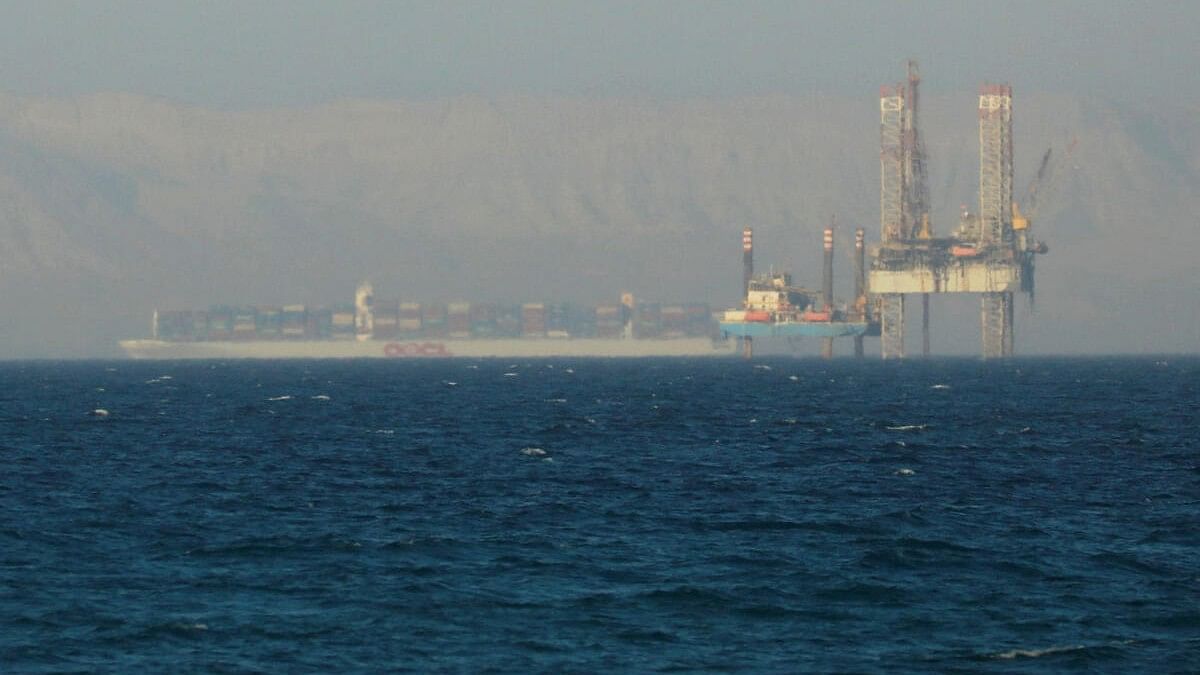
A container ship crosses an oil platform at the Gulf of Suez towards the Red Sea before entering the Suez Canal, outside of Cairo, Egypt.
Credit: Reuters Photo
If it was not enough that the Russia-Ukraine strife disrupted trade over the past two years, the Houthi attacks on ships sailing through the Red Sea since October, has only exacerbated the distress traders are being put to. They find themselves negotiating the challenges of rerouting and the resultant time-lags and additional costs. That apart, the rising risks have only translated into higher insurance premiums on their cargo and in some cases absolute absence of insurance cover.
According to most exporters DH spoke to, cargo insurance premiums have gone up 15-20 per cent for those shipping through the Red Sea. Insurers have also introduced an additional war surcharge of 15-20 per cent in the premia for sea routes around Russia and Ukraine.
“The attacks have pushed up the cost of shipping by 20-25 per cent by disrupting a key trade route between Asia and Europe, used widely by commercial vessels. Marine war insurance premium rates will rise by over 10 per cent for commercial vessels operating in the Red Sea and the Gulf of Aden following airstrikes on Houthi targets,” Sharad Mathur, managing director and CEO, Universal Sompo General Insurance told DH.
Likewise, BV Krishna Rao, President, The Rice Exporters’ Association, added that the insurance premium for rice alone has gone up 40-70% over the past year. “We are coping by passing on half the additional burden to our buyers,” he explained.
Most insurers, in fact, are issuing advisories against charting the Red Sea waters - the most convenient route for Indian trade to the West. “In case we adopt alternate routes like Cape of Good Hope in South Africa, then the vessels take 10-15 days extra to sail to their destination”, informed Suresh Rekhawat, head-international logistics, Goenka Group, adding, “It means an additional cost burden.”
As others point out, new routes means anchoring at new ports that could cost more. This only adds to the woe of other rising costs the traders are already shouldering. According to Veera Bhadra Reddy, a Kakinada-based shrimp exporter, the container costs have gone up 40-50% since October. Now with the changed routes the transit time has stretched by 15-55 days.
Some worries have been raised about how this impacts perishable cargo, but seafood exporters explained that using Reefer containers that keep their products at -18 degree celsius helps preserve the products for up to two years. The catch is elsewhere. For one, they are losing to competition from Ecuador - which is untouched by the problem. “Until the cargo reaches its destination, you don’t get paid by the buyers,” Reddy pointed out.
While the shippers are trying to pass on the burden of the higher premium to their customers, they also find themselves having to bite the bullet, especially where the competition is stiff.
“Pursuant to the joint war committee (JWC) of Lloyd's Market Association (LMA) and other reinsurers declaring the Red Sea waters as high risk area, we are seeing major shipping companies proactively avoiding this route. To prepare for any impact on marine insurance, we’ve duly notified our clients on the increased risk to their cargo. For those who still choose to transit through that route, we’re providing cover with an additional war risk premium,” said Balachandran Shioram, vice president and national head of marine cargo underwriting at Tata AIG.
The fall out of the situation will see the demand for coverage for risking the most convenient route rise, while the number of insurers willing to cater to it would dwindle, said Hiten Kothari, chief underwriting officer and chief actuary, HDFC ERGO General Insurance.
“We are closely monitoring the situation and will assess it in collaboration with our reinsurer support. Subsequently, we will make informed decisions based on our evaluation,” said TA Ramalingam, chief technical officer, Bajaj Allianz General Insurance, on his company’s position.